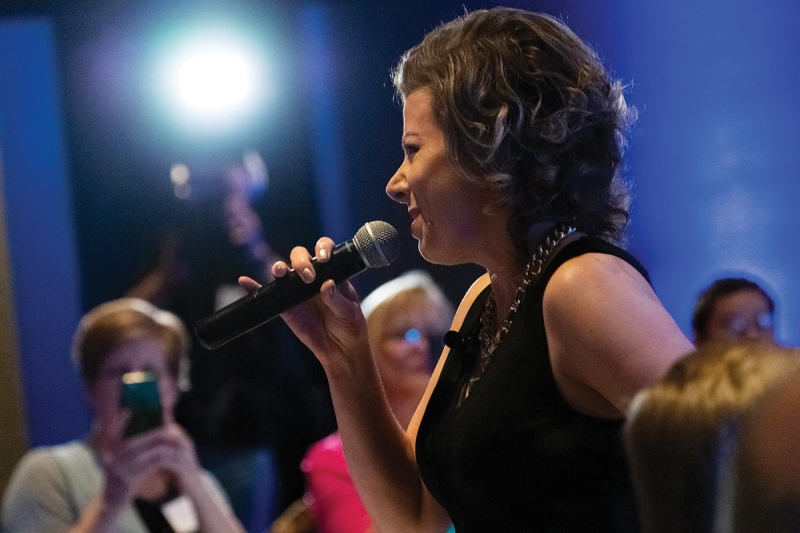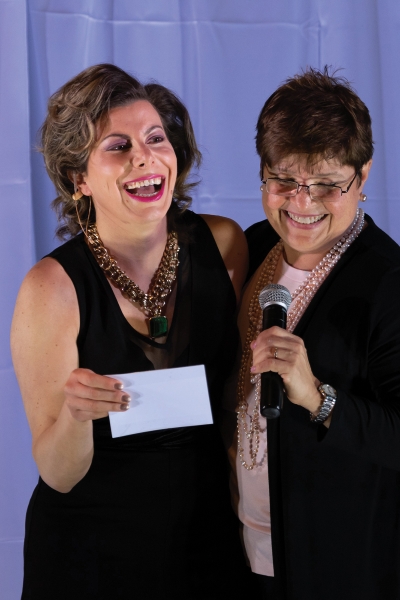Pro tips for better presentation and speaking skills
Cindy Ashton's tips for better business communications—all based on the premise that how you’re communicating is just as important as what you’re communicating.
• August 2019 issue
Are you talking yourself out of sales? Have you considered the way you’re presenting yourself to clients? Your mannerisms and delivery might be affecting your client communications.

Cindy Ashton, an internationally known presentation strategist and CEO of Minerva Enterprises, thinks about these things all the time. Over 20 years of consulting on presentation skills, speaking voice, body language, and content delivery, she’s established tips for better business communications—all based on the premise that how you’re communicating is just as important as what you’re communicating.
For Ashton, the process begins with a look at your energy. Are you focused and attentive? Are you presenting yourself as confident and authoritative but not overbearing? People tend to hold tension in their shoulders, neck, and upper back, making them seem stiff and aggressive. Or they slouch, rounding their shoulders and portraying themselves as smaller, insecure, less trustworthy.
To avoid these issues and communicate effectively, Ashton suggests establishing a simple “pregame” routine to relax your body and get yourself in the zone for a productive business conversation.
“We all carry tension from what we do habitually, and that affects our body posture, which affects our energy, which affects our speaking voice, which affects how we come across to people in a conversation,” says Ashton. “We need to remove that tension so we can present ourselves more effectively.”
The winning pregame routine
- Scan and stretch. Move your body to remove stiffness and roll your shoulders as you breathe deeply. Take 30 seconds to close your eyes and scan your body from top to bottom, taking note of where you’re tense. Then stretch out that part of your body. Regulate your breathing to be easier and smoother.
- Cactus arms. Put your arms up like you’re a saguaro cactus or a football goal post. Then stretch your back so your scapula are back, drop your tailbone, then stretch through your chest and shoulders. Breathe deeply to increase the stretch. After 30 seconds, release and relax. Do this several times over the course of three or four minutes.
- Open your face. Once you’ve released all that tension, it’s time to make your voice more resonant, more vibrant. Open your eyes and mouth really wide, and then squeeze them down really small. Do that five times in a row. Then gently massage your face, rubbing any area that feels like it needs relaxing.
- Hum. That’s right, hum. Go up and down the musical scale, feel the vibration around your mouth, nose, and cheeks. Shift where the sound is so you feel natural, loud, and confident, with your voice not stuck in your throat.
- Breathe. Inhale into the belly so it expands. Exhale and release the air, collapsing the belly. Breathe in for two to three counts, exhale for two to three counts. Balance the length of your inhales and exhales. Once you’re in balance, exhale longer than you inhale (breathing in two to three counts, out four to five counts). The objective is to exhale all the air fully and regulate your breathing. Breathing this way stimulates the parasympathetic nervous system, relaxing the mind and releasing tension in the body. Do this for a few cycles, and you’ll start to feel more grounded and focused.
- Establish a sensory trigger. Imagine the person in your life who you love the most, your biggest supporter. Think of a specific thing on their face that lights you up. When feeling nervous, imagine that specific thing. Doing this helps shift your energy back to warmth and softens you. People will be able to feel the difference. This process also puts your attention on someone else, so you’re not hyper-focused on yourself and your own insecurities.
The result? Done correctly, a relaxing pregame routine like this will improve your posture so you look confident without trying
too hard. It also relaxes your voice so it comes out louder and more naturally without being pushy or aggressive. Now you’re ready to have an important conversation with a client.

Meeting face to face
After you’ve relaxed and focused, start client meetings from a position of confidence. Much of this process involves fundamental lessons of personal interaction:
- Start with a firm handshake. Limp handshakes make you seem weak or passive. Overly tight grips are read as aggressive.
- Look the client in the eye. Be direct to show your engagement with the other person, but avoid a piercing stare that can make people uncomfortable.
- Don’t fidget. Shifting and fidgeting makes you seem nervous, apprehensive, or preoccupied.
- Keep your hands relaxed. Don’t play with your hands. It’s distracting and makes you appear uncomfortable.
Let go of perfect
You might be thinking, This is a lot to consider. How do I do all these things without making myself more nervous or overthinking every move? Ashton suggests forgetting about being perfect. Let go of it. Yes, you want to eliminate as many bad patterns as possible, but understand that perfect posture and presentation aren’t necessary. You’ll move in that direction little by little. In the meantime, just relax and be yourself.Next, stop focusing so much on yourself. Instead, direct your energy toward the person across from you. Be involved with your audience. If you’re paying attention to the other person, you won’t have time to be nervous about yourself.
Postures and patterns that push people away
- Leaning in too much
- Speaking too fast
- Getting too close
- Placing your hands on your hips
- Crossing your arms
- Clasping your hands below your waist
- Standing too tall or stiff
- Pushing your voice from your throat or chest
. . . and those that make you look apprehensive
- Slouching
- Talking too slowly or too quietly
- Not maintaining eye contact
- Fidgeting, tapping, shuffling feet, swaying
- Lowering your head
The cadence of the sale
So you’re focused, grounded, avoiding bad habits, and attentive to your audience. The final step is to think about how to present your offer.
There’s a cadence to an effective sales conversation. It starts with a gradual build up, then the pace quickens as you’re explaining the process, the benefits, the features. The idea is to speed up to get people excited. Ask leading questions that encourage them to say “Yes.” Build the tempo, build the excitement, get them agreeing with you. Speed up, speed up …
And then when you present your offer, slow down.
Lay out your proposal clearly.
Slowly.
Confidently.
And then pause.
Just wait.
Be quiet and let it sit there for a few seconds—or minutes, if necessary.

“This is where people lose a sale,” says Ashton. “They talk too quickly after presenting the offer, and they talk themselves out of the sale. People think if they don’t get a response right away, the client might not be interested, and they start to undersell themselves. They backpedal on pricing or start adding things to sweeten the deal. But sometimes clients just need time to process. Let your clients think and respond in their own way. That gives you power over the price and the process.”
When the client does respond, if they come back with a counter offer, questions, or conditions, don’t panic and don’t start backing down. Instead, listen, then ask more questions.
“People want to feel that they are heard,” says Ashton. “So listen. As salespeople, we tend to talk too much. That’s often because we’re nervous. So ask more questions, make that effort to understand, dig deeper. Stay calm, friendly, and connected. Explore alternatives and get to the underlying issues. Asking questions is your best defense.”
If the sales negotiation goes your way, great. If not, you’ve still presented yourself as a competent professional with a strong value proposition. That will leave a strong impression, and who knows, it could set the scene for a later sale once that client has fully considered your offer.
Jeff Kent is the editor-at-large of Professional Photographer.



